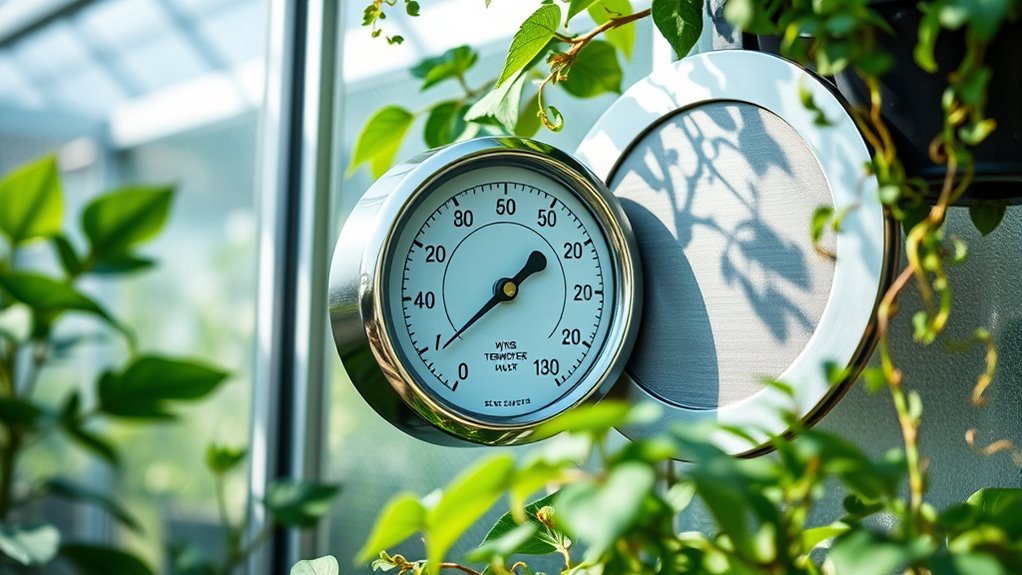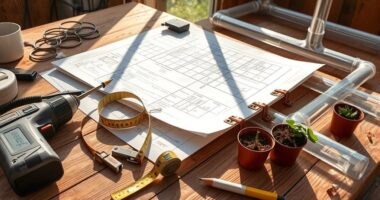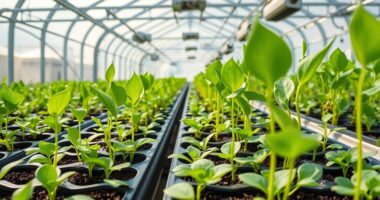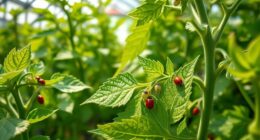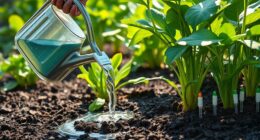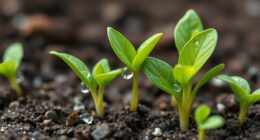Using a greenhouse thermometer and hygrometer helps you monitor and control temperatures and humidity levels, ensuring your plants stay healthy and stress-free. Place the thermometer in different areas to detect temperature variations and adjust your heating or cooling systems as needed. Use the hygrometer to keep humidity within ideal ranges, preventing problems like dehydration or mold. Keep an eye on these tools regularly, and you’ll discover more tips for creating a thriving greenhouse environment.
Key Takeaways
- Place the thermometer and hygrometer in different areas to monitor temperature and humidity variations throughout the greenhouse.
- Regularly check and record readings to identify trends and detect environmental fluctuations promptly.
- Adjust heating, cooling, misting, or ventilation systems based on the sensor data to maintain optimal growing conditions.
- Use the devices to prevent extreme temperature and humidity levels that can stress plants or promote pests and diseases.
- Calibrate sensors periodically for accurate measurements and reliable climate control in your greenhouse.
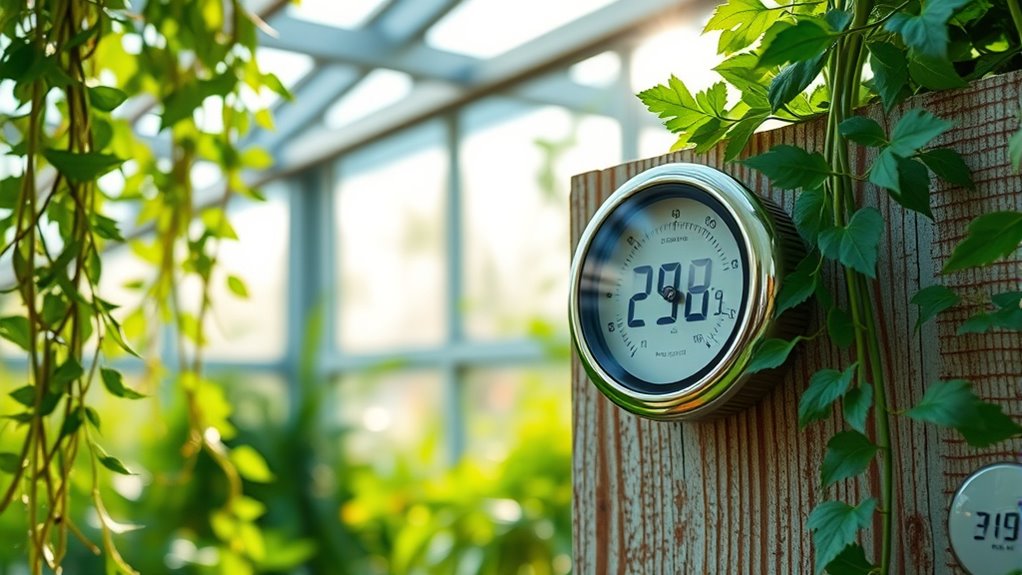
Maintaining the right environment in your greenhouse is essential for healthy plant growth, and a reliable thermometer and hygrometer are key tools for this. These devices help you monitor the climate closely, ensuring your plants have optimal conditions to thrive. Proper climate monitoring is crucial because even slight fluctuations in temperature and humidity can impact plant health, stunt growth, or invite pests and diseases. By regularly checking your thermometer and hygrometer, you gain real-time insights into your greenhouse’s environment, allowing you to make immediate adjustments when needed. This proactive approach keeps your plants in a stable, ideal range, minimizing stress and promoting vigorous growth. Additionally, incorporating advanced sensors that support 8K resolution can provide more precise readings and data visualization for comprehensive climate management.
When you use a greenhouse thermometer, you’re directly tracking the air temperature inside your space. This information lets you regulate heating or cooling systems precisely, preventing temperatures from dropping too low or rising excessively high. For most plants, maintaining a specific temperature range is vital; too cold, and growth slows or halts, too hot, and plants may wilt or suffer from heat stress. An accurate thermometer provides the data you need to keep conditions consistent, especially during seasonal changes or unexpected weather fluctuations. It’s also beneficial to place the thermometer in different areas of your greenhouse to identify any temperature variations caused by sunlight exposure, airflow, or equipment placement.
Similarly, a hygrometer measures the humidity levels, which are equally significant for plant health. If the humidity is too low, your plants may experience dehydration, leaf edges might brown, and pests like spider mites could become more prevalent. Conversely, overly high humidity encourages mold, mildew, and root rot. Monitoring humidity with a hygrometer allows you to adjust misting, ventilation, or dehumidification systems accordingly. For example, during dry winter months, you might need to increase humidity to prevent stress, while in damp conditions, reducing moisture helps prevent fungal issues. Consistent climate monitoring enables you to create a stable environment that supports healthy root development and robust foliage.
Frequently Asked Questions
How Often Should I Calibrate My Greenhouse Thermometer and Hygrometer?
You should calibrate your greenhouse thermometer and hygrometer at least once a month to guarantee device accuracy. Regular calibration helps detect any drift in measurements caused by temperature changes or device wear. If you notice inconsistent readings or after any impact or exposure to extreme conditions, calibrate immediately. Consistent calibration maintains reliable data, so you can confidently monitor and control your greenhouse environment for ideal plant growth.
Can I Use a Digital Thermometer and Hygrometer Outdoors?
Think of your outdoor space as a wandering ship on unpredictable seas. Yes, you can use digital outdoor weatherproof devices, but guarantee they’re built to withstand the elements. Look for models with waterproof, dustproof, and durable features. They’ll give you accurate readings rain or shine, helping you manage your garden or patio efficiently. Just remember, choosing the right weatherproof device is key to sailing smoothly through changing weather conditions.
What Is the Ideal Temperature Range for Greenhouse Plants?
The ideal temperature range for greenhouse plants is typically between 65-75°F during the day and around 55-65°F at night. You should focus on temperature regulation to optimize plant growth, ensuring it doesn’t get too hot or cold. Use your thermometer to monitor conditions closely, adjusting ventilation, shading, or heating as needed. Maintaining consistent temperatures helps your plants thrive and promotes healthy, vigorous growth.
How Do I Interpret Humidity Levels in My Greenhouse?
You should interpret humidity levels by observing fluctuations that can affect plant health. Consistent readings indicate stable conditions, while sudden changes may signal issues like poor ventilation or excess moisture. Use your hygrometer to monitor these variations regularly, helping you adjust watering or ventilation as needed. Keeping humidity within ideal ranges supports healthy growth, prevents disease, and ensures your plants thrive. Regular plant health monitoring makes managing humidity much easier.
Are There Maintenance Tips to Extend Device Lifespan?
To extend your device’s lifespan, regularly calibrate the sensor to guarantee accuracy, which also maintains reliable readings. Keep the device clean and dry, avoiding exposure to extreme temperatures or direct sunlight, as these can damage the sensor. Store it properly when not in use, and check for signs of wear. Proper maintenance not only boosts device durability but also ensures consistent, precise measurements for your greenhouse environment.
Conclusion
By using a greenhouse thermometer and hygrometer, you monitor temperature and humidity with precision, ensuring ideal plant growth. You maintain the right conditions, prevent problems, and promote healthy development. You track changes, respond promptly, and create a stable environment. You control the climate, support your plants, and achieve success. With these tools, you stay informed, stay proactive, and stay confident—because in gardening, consistent care leads to vibrant, thriving plants.
